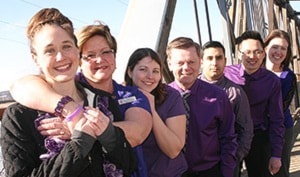Millions of people suffer from disease and illness but only a fraction find the strength and determination to make a difference. For NatashaWasmuth, who has suffered with epilepsy since the age of 15, that strength resulted from life-changing surgery.
“With epilepsy you never truly know what each day brings,” she said.
“It can be one of the most constructive and happy days and you feel great. Then you wake up on the floor in someone’s arms with no recollection of what happened.”
For Natasha, many dangerous experiences such as waking up on the bathroom floor after falling out of the shower, carry all too vivid memories of living with epilepsy. Perhaps the most terrifying was her first grand mal (tonic clonic) seizure.
“I came to with a bedroom full of police and the first thing my eyes focused on, two feet from my head, was the gun on a cop’s hip,” she said.
“That was 11 years ago but the experience was so vivid it seems like last week.”
For 17 years Natasha did the rounds with various medications, feeling like a guinea pig, none working very well for her, until a lesion was found on her left temporal lobe.
She was told she had refractory epilepsy, which meant no matter what she did or other medications she tried, her seizures would continue to get worse.
“There is no way to describe how I felt hearing that news,” she said.
“I cried for months.”
However, this news kick-started a new journey for Natasha. The only option left was brain surgery, always a last resort. Before she would need to make any decision, whether or not she was a candidate for surgery had to be determined.
For an adult considering brain surgery for their epilepsy, they must be admitted to the Epilepsy Clinic Seizure Investigation Unit (SIU) at Vancouver General Hospital, where trained epileptologists try to induce seizures for answers that can’t be found through any other avenue.
“That was the first day of an entirely new life for me,” Natasha said.
“Although it took my stubborn brain 17 days to have enough grand mals for the team to determine if I was a suitable candidate.”
Three weeks later she heard the news, she was able to have the surgery.
Despite the fears, when she weighed the prospect of a life of debilitating seizures and no independence (with every grand mal seizure there is immediate loss of license), against the risks of brain surgery, having the lesion removed seemed the right choice. Although there have been some difficult adjustments over the past 18 months, the surgery was successful and Natasha no longer lives in fear.
However, with only two beds in the SIU and thousands of epilepsy patients potentially eligible for surgery, some wait years to go under investigation. Every seizure causes damage to the brain, which “makes the long wait unacceptable” she says, and has since become an SIU fundraiser.
“That hospital and the people who gave me a new life are a part of my heart, my survival, it is time to give back,” she said.
In 2014, the World Health Organization (WHO) raised the number of people worldwide with epilepsy from 50 million to 70 million.
In Canada, one in 100 people suffer from epilepsy – more than multiple sclerosis, cerebral palsy, muscular dystrophy and Parkinson’s disease combined.
The WHO also states epilepsy as a worldwide serious health concern, accounting for one per cent of the global burden of disease – equivalent to lung cancer in men and breast cancer in women.
The repercussions of epilepsy are vast. A number of seizure types impair consciousness and risk safety; the stress that comes with loss of license; the side effects of heavy epilepsy medication can be teeth and gum destruction, digestive issues and an inability to work, and if the seizures worsen, it can trigger a change in medication often setting off another round of the guinea pig process.
March is Epilepsy Month across Canada and in 2014 Natasha launched epilepsyQuesnel (eQ) and a fundraising campaign to help VGH’s current goal of two more SIU beds.
She is grateful to the very special people at VGH but also to the people of Quesnel who have embraced this important but little-known cause.
“Our first fundraising efforts were in March 2014, and it proved our community is nothing short of stellar,” she said.
“Support came in from every corner of the city, from business and personal donations to a massive sale of purple cookies – 1,758 were purchased in three weeks – and included with other sales such as purple flowers, eQ’s donation to the VGH SIU was $3,242.”
Telling her story hasn’t gotten any easier for Natasha but she’s willing to do whatever it takes
to make a difference for so many British Columbians.
“I will work on this until SIU three and four are in place and the wait list for lives to be saved is cut in half.”
To watch her provincial video visit http://vghfoundation.ca/natashas-story, and anyone wishing to donate to eQ’s fundraising can visit www.tinyurl.com/natashas-story.
Watch for more information in the lead up to Purple Day, March 26 and how you can
help Natasha and eQ’s efforts for those with epilepsy.
